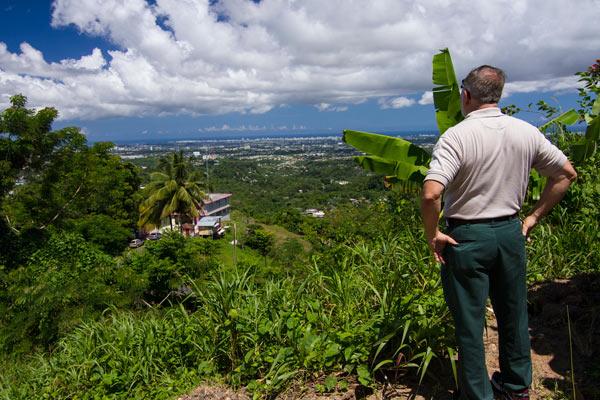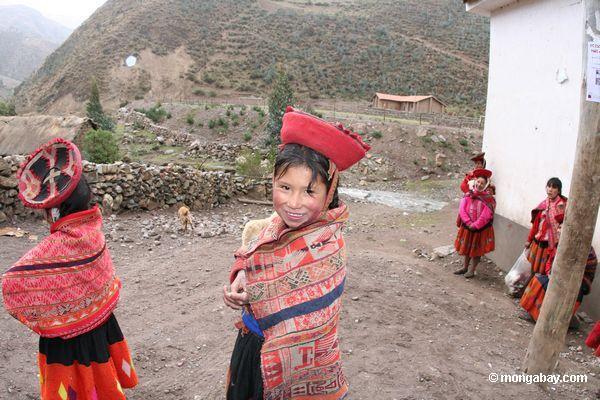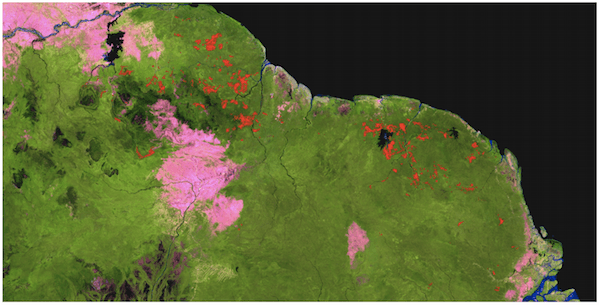Think first before you eradicate non-native species says Dr. Ariel E. Lugo, the current director of the International Institute of Tropical Forestry within the USDA Forest Service, based in Puerto Rico. Lugo, an accomplished ecologist, supports the idea that both native and non-native plants have important roles to play in conservation efforts.
“Many conservationists object to the presence of non-native species and pursue instead a natives-only strategy of conservation. In Puerto Rico, such a traditional conservation approach would require us to deforest 75 percent of our forest cover, which is the proportion of the island’s forests dominated by non-native trees,” Lugo told mongabay.com in a recent interview. “Recognizing that all lands and all species have conservation value is a key breakthrough for effective forest conservation.”
Because of the depth of his experience, Lugo is frequently called on to appear as an expert witness for federal environmental court cases. He has over 300 publications in books and scientific journals, is a Member-at-Large of the Board of the Ecological Society of America, and a founding member of the Society for Ecological Restoration. In addition, he serves as the editor of Acta Cientifica and on the editorial boards of numerous other journals.
“The unprecedented and directional environmental change that is defining the era of the Anthropocene makes obsolete many of our beliefs and paradigms developed during the Holocene; an era where we thought conditions were cyclical,” explained Lugo. “If conditions were cyclical, we can look at the past to learn about the future. However, if they are not cyclical but follow an ever changing and unpredictable trajectory (as expected from climate change), then the past becomes less relevant and anticipating the future more relevant.”
By studying “novel forests” on his native Puerto Rico, Lugo has discovered that even though these forests are largely dominated by non-native species, and are vastly different than past forests, they provide essential ecosystem services. Perhaps even more importantly, these ecosystems “shows how natural processes lead to tropical forests that can function normally on degraded landscapes where human activity has previously deforested the land and caused high levels of soil erosion and compaction,” according to Lugo.
He added that “knowing when to intervene with natural process and when to allow these processes to unfold is probably the single-most challenge to conservation and thus the most important break thought that is ahead of us.”
An Interview with Dr. Ariel Lugo
Mongabay: What is your background? How long have you worked in tropical forest conservation and in what geographies? What is your area of focus?
Ariel Lugo: I am a native of tropical Puerto Rico, have been studying or working in tropical forests for about 50 years. I am an ecologist and have studied mangroves and tropical dry, moist, wet, and rain forests throughout the world and intensively in the Caribbean. My interest in these systems has always been their structure, species composition, and functioning as ecosystems. The functional aspects of my research involve speed and direction of succession, forest productivity and nutrient cycling, and the roles forests play in supporting human activity.
Mongabay: Are you personally involved in any projects or research that you feel represents emerging innovation in tropical forest conservation?
Ariel Lugo: I am concentrating my research on novel forests, which are forests whose species composition is different from the species composition of historical forests at the location where they develop. In Puerto Rico, novel forests include native species but are dominated by non-native species. They dominate the landscape of the island and provide vital services to people. The conservation relevance of this research is that it shows how natural processes lead to tropical forests that can function normally on degraded landscapes where human activity has previously deforested the land and caused high levels of soil erosion and compaction. Our research has shown that native tree species cannot colonize these abandoned and degraded lands but luckily non-native trees have the capacity to colonize and re-establish forest conditions where native species, including endemic ones, can grow. Many conservationists object to the presence of non-native species and pursue instead a natives-only strategy of conservation. In Puerto Rico, such a traditional conservation approach would require us to deforest 75 percent of our forest cover, which is the proportion of the island’s forests dominated by non-native trees. Recognizing the ecological value of non-native species is a conservation innovation that all conservationists should consider before they undertake species eradication programs. The solutions to forest conservation problems require ecological understanding and scientific knowledge so that conservation programs can be more effective and sustainable.
Mongabay: What’s the next big thing in forest conservation? What approaches or ideas are emerging or have recently emerged? What will be the catalyst for the next big breakthrough?
Ariel Lugo: Recognizing that all lands and all species have conservation value is a key breakthrough for effective forest conservation. This breakthrough is made imperative by the rapid and unpredictable rate of environmental change that humans are imposing on Planet Earth. The unprecedented and directional environmental change that is defining the era of the Anthropocene makes obsolete many of our beliefs and paradigms developed during the Holocene; an era where we thought conditions were cyclical. If conditions were cyclical, we can look at the past to learn about the future. However, if they are not cyclical but follow an ever changing and unpredictable trajectory (as expected from climate change), then the past becomes less relevant and anticipating the future more relevant. Because natural processes are fine-tuned by natural selection, we must be ready to work in harmony with natural processes to assure our adaptability to a changing world. Working against natural processes is costly and not sustainable. In the Caribbean, tropical forests are adapting to change by the remixing of forest species, regardless of their geographic origins. This is an emerging lesson for conservation and does not support the single-focus notion of eradication of non-native species. Knowing when to intervene with natural process and when to allow these processes to unfold is probably the single-most challenge to conservation and thus the most important break thought that is ahead of us.
Mongabay: What do you see as the biggest development or developments over the past decade in tropical forest conservation?
Ariel Lugo: Tropical forests attracted the attention of early explorers because of their luxuriance and diversity. Scientists were challenged by this complexity and dedicated decades of study to unravel its meaning and try to understand its causes. To do so, scientists focused on mature forests or forests they thought were pristine and not affected by humans. This focus on mature forests shaped the development of tropical ecology and ecosystem science. Over the last two decades we have realized that there is a human imprint in forest stands that we deemed pristine. Moreover, the global area of secondary tropical forests (forests in different stages of recovery after human or natural disturbances) is now larger than the area of tropical mature forests and ecologists have now began to pay attention to these secondary forests. The shift in attention towards secondary forests is a positive development in the science of tropical ecology because it places the scientific community closer to the point where human activity intersects with forest ecology. Ultimately scientists will have to take another step towards novel forests, which are even more closely related to people, but for now, focusing on secondary forests is huge.
Mongabay: What isn’t working in conservation but is still receiving unwarranted levels of support?
Ariel Lugo: Conservation benefits from the passion for the preservation of species and this is fundamental for the success of conservation activities. However, conservation must also be anchored in science, particularly in light of the complexity of nature and the unpredictable conditions of the Anthropocene. Conservation does not work when emotions take over and scientific realities are ignored. So, the current war on non-native species, which is justified under some but not under all conditions, leads to ineffective, counterproductive, and anti-scientific attitudes, which are captured by the notion of “shoot first and ask questions later.” Blindly ignoring non-native species and non-protected lands in terms of their conservation value, limit conservation approaches to an increasingly smaller fraction of the biota and the Earth’s forests areas. Many sectors of the conservation movement are not understanding that conservation must be adaptive, i.e., be a learning activity that adjusts to emerging conditions, which is why the activities of those sectors of the movement are not working.
This article was originally written by Liz Kimborough, a contributing writer for news.mongabay.com. For the original article and more information, please click HERE.




Friends Read Free